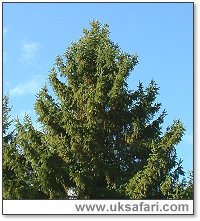
|

|
|
 Sent
to you Sent
to you
by e-mail
|
|
Simply
enter your details and hit the send button
more
info |
|


Click Here

Links
Advertise
Terms of Use
Contributors
About Us
Contact Us
|
 |
Go back
 | Bookmark
| Bookmark
 | Print Page
| Print Page  | E-Mail Us
| E-Mail Us 
 
 Photo: G. Bradley
Photo: G. Bradley
|
|
UK
Safari Tip:
Need help identifying trees? Try the colourful fold out chart called
"Tree Name Trail" from the Nature Shop - click
here
|
|
Latin name: Picea abies
Size: Can grow to 38 metres tall.
Distribution: Found throughout the UK.
Flowering months: May
Special features: Norway Spruce trees grew here before the ice age, but were killed off by the cold. They were reintroduced to the UK in around 1500. It thrives in damp areas.
They are perhaps best known as the traditional 'Christmas tree'. The old German custom of decorating Spruce trees was made fashionable in the UK by Prince Albert and Queen Victoria after they decorated trees at Windsor Castle in the 1840's. Their conical shape with drooping lower branches, and upward pointing high branches made them ideal for decorating with lights, tinsel and gifts.
The Norway Spruce is grown throughout northern and central Europe for its timber, which is known as 'deal' or 'white wood'. Spruce timber is flexible and durable. Its relative lightness, long length and straightness make it ideal for telegraph poles, wooden ladders, oars, roofing timbers and paper pulp. Turpentine is also extracted from the stem.
 The male flowers, which are grouped together at the tips of branches, turn yellow when they release their pollen. The female flowers are pink at first. Initially they stand upright, but after pollination they turn green and hang downwards. The cones which develop can grow to 20cms long. The male flowers, which are grouped together at the tips of branches, turn yellow when they release their pollen. The female flowers are pink at first. Initially they stand upright, but after pollination they turn green and hang downwards. The cones which develop can grow to 20cms long.
Norway Spruce leaves are squarish in section and last for approximately 7 years. The bark of the tree is red-brown in colour and becomes flaky with
age.

UK Safari Tree Section
|
 |

|